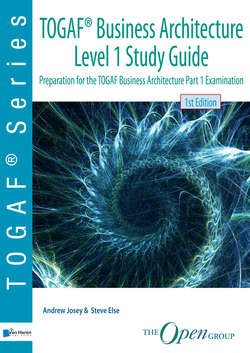Читать книгу TOGAF® Business Architecture Level 1 Study Guide - Andrew Josey - Страница 18
На сайте Литреса книга снята с продажи.
2.4.1 Structure of the TOGAF Documentation
ОглавлениеThe TOGAF documentation consists of the TOGAF standard, and a portfolio of guidance material, known as the TOGAF Library, to support the practical application of the standard. The TOGAF standard is at the heart of the TOGAF Library, as shown in Figure 1.
Figure 1: The TOGAF Library
The standard is divided into parts, each addressing distinct topics including methods, techniques, etc. This is summarized in Table 1.
Table 1: Structure of the TOGAF Standard
| TOGAF Part | Summary |
| Part I: Introduction | This part provides a high-level introduction to the key concepts of Enterprise Architecture and, in particular, to the TOGAF approach. It contains the definitions of terms used throughout the standard. |
| Part II: Architecture Development Method (ADM) | This part is the core of the TOGAF framework. It describes the TOGAF Architecture Development Method (ADM) – a multi-phase, iterative approach to developing an Enterprise Architecture. |
| Part III: ADM Guidelines and Techniques | This part contains a collection of guidelines and techniques available for use in applying the TOGAF approach and the TOGAF ADM. (Additional guidelines and techniques are also in the TOGAF Library.) |
| Part IV: Architecture Content Framework | This part describes the TOGAF content framework, including a structured metamodel for architectural artifacts, the use of re-usable Architecture Building Blocks (ABBs), and an overview of typical architecture deliverables. |
| Part V: Enterprise Continuum and Tools | This part discusses appropriate taxonomies and tools to categorize and store the outputs of architecture activity within an enterprise. |
| Part VI: Architecture Capability Framework | This part discusses the organization, processes, skills, roles, and responsibilities required to establish and operate an architecture practice within an enterprise. |
Accompanying the standard is the TOGAF Library4. The TOGAF Library is a library of resources to support usage of the TOGAF standard. It contains guidelines, templates, patterns, and other forms of reference material to accelerate the creation of new architectures for an enterprise.
Recently added are the TOGAF Series Guides, a series of documents containing detailed guidance on how to use the TOGAF framework.
The current titles in the TOGAF Series Guides5 are summarized in Table 2.
Table 2: TOGAF Series Guides
| Title | Description |
| TOGAF Series Guide:A Practitioners’ Approach to Developing Enterprise Architecture Following the TOGAF ADM | This document puts forward an approach to develop, maintain, and use an Enterprise Architecture that aligns to a set of requirements and expectations of the stakeholders and enables predictable value creation. |
| TOGAF Series Guide:Architecture Project Management | This document provides architecture project teams with an overall view and detailed guidance on what processes, tools, and techniques of PRINCE2® or PMBOK® can be applied alongside the TOGAF ADM for project planning, monitoring, and control. |
| TOGAF Series Guide:Business Capabilities | This document describes what a business capability is, and how business capabilities can be used to enhance business analysis and planning. |
| TOGAF Series Guide:Business Models | This document provides a basis for Enterprise Architects to understand and utilize business models, which describe the rationale of how an organization creates, delivers, and captures value. |
| TOGAF Series Guide:Business Scenarios | This document describes the business scenarios method, which is a technique to validate, elaborate, and/or change the premise behind an architecture effort by understanding and documenting the key elements of a business scenario in successive iterations. |
| TOGAF Series Guide:Information Mapping | This document addresses how to provide the architect with a means to articulate, characterize, and visually represent the information that is critical to the business. |
| TOGAF Series Guide:The TOGAF Integrated Information Infrastructure Reference Model (III-RM):An Architected Approach to Boundaryless Information Flow™ | This document addresses the TOGAF Integrated Information Infrastructure Reference Model (III-RM) in terms of its concepts, an overview, and its detailed taxonomy. |
| TOGAF Series Guide:The TOGAF Leader’s Guide to Establishing and Evolving an EA Capability | This document puts forward advice on establishing an Enterprise Architecture Capability that aligns to a set of requirements and expectations specific to each enterprise. |
| TOGAF Series Guide:The TOGAF Technical Reference Model (TRM) | This document describes the TOGAF Technical Reference Model (TRM), including the core taxonomy, graphical representation, and the detailed platform taxonomy. |
| TOGAF Series Guide:Using the TOGAF Framework to Define and Govern Service-Oriented Architectures | This document provides guidance on how the architect can use the TOGAF standard to develop, manage, and govern Service-Oriented Architectures (SOA). |
| TOGAF Series Guide:Value Streams | This document addresses how to identify, define, model, and map a value stream to other key components of an enterprise’s Business Architecture. |
